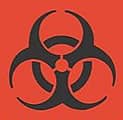
It’s often assumed that a biological agent’s risk group (RG) and the biosafety level at which it should be handled are synonymous, when in fact this is not always the case. In addition to an agent’s risk group, there are many other factors to consider when designating a biosafety level for a biological agent.
Risk group describes the relative risk to the individual and the environment by the organism. There are four risk group classifications described in the NIH Guidelines and in the World Health Organization’s Laboratory Biosafety Manual:
- Risk Group 1 agents are not associated with disease in healthy adults
- Risk Group 2 agents are associated with human disease that is rarely serious and for which preventative or therapeutic interventions are often available
- Risk Group 3 agents are associated with serious or lethal human disease for which preventative or therapeutic interventions may be available
- Risk Group 4 agents are likely to cause serious or lethal diseases for which preventative or therapeutic interventions are not usually available.
Risk Group 3 agents have high individual risk and low community risk, while Risk Group 4 agents have both high individual risk and high community risk.
Similar to risk groups, there are four biosafety levels (BL1-BL4) established by the CDC/NIH and described in their publication Biosafety in Microbiological and Biomedical Laboratories (BMBL). In addition to the four standard biosafety levels, BL2+, or BL2 enhanced, is often used as a bridge between BL2 and BL3.
Generally speaking, this level consists of BL3 safety practices performed in BL2 facilities. In contrast to risk groups, biosafety levels prescribe the work practices, engineering controls, personal protective equipment, and facility specifications required for working safely with biological agents to protect employees and the environment.
Risk group and biosafety level are often the same (i.e. risk group 1 organisms are handled at biosafety level 1), but not always. The risk group classification is only one factor to consider when determining the biosafety level for a particular agent. Only a full risk assessment can determine the appropriate biosafety containment level for each biological agent in use.
For instance, an agent can be classified as RG1, but BL2 work practices may be recommended due to the high likelihood of aerosol generation and/or the scale of work.
A risk assessment determines the appropriate biosafety level by identifying the hazardous characteristics of the biological material, identifying work practices that have the potential to create exposure hazards, and addressing the consequences of exposure. In conducting a risk assessment, factors to consider include:
- Infectious dose of the organism, or the amount of a biological agent that is required to establish an infection
- Virulence, or the degree of harm caused by a biological material to its host
- Likely routes of exposure
- Viability of the organisms in the lab environment
- Host range which a particular biological material is able to infect
- Availability of suitable disinfectants
- Availability of suitable prophylaxis to prevent disease
- Scope and scale of work
- Experience of lab personnel
A risk assessment that considers all of these factors should be conducted by the biosafety officer, a biosafety professional, or another knowledgeable individual in order to assign the appropriate biosafety level for the biological material being used. For more information on risk groups and biosafety levels, or for assistance with conducting risk assessments at your facility, please email [email protected].
This blog was written by Beth Graham, our Associate Director of Quality, Research, and Training who has been with Safety Partners Inc. for the last 11 years.
